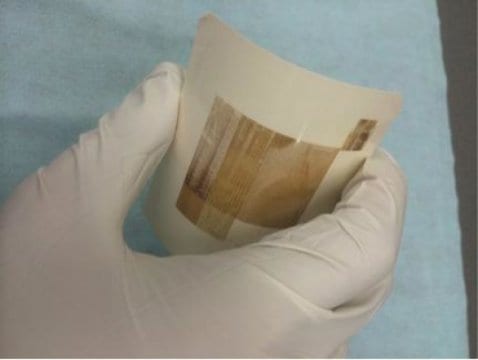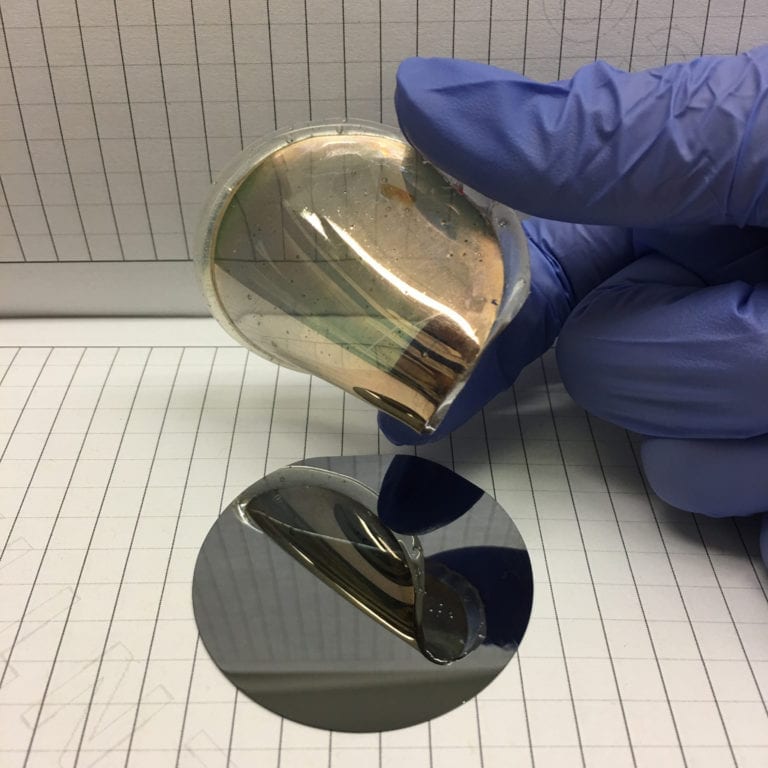
Researchers from Delft University of Technology in the Netherlands have developed a method that allows silicon ink in polycrystalline form to be printed on a substrate, a breakthrough that could open the door for future flexible electronic devices.
Printable electronic devices are of great interest to the electronics industry due to their simplicity and relatively low cost to manufacture. In comparison, standard methods of fabrication require complicated processes such as photolithography, etching, deposition and other techniques, most of which are supported by vacuum systems.
Printable electronics use semiconductor materials printed as ink on many types of substrates. These methods allow for the fabrication of flexible circuits such as rollable displays or flexible sensors. The semiconductor materials normally used are organic and metal-oxide semiconductors; however, these semiconductors lack the reliability and charge-carrier mobility of silicon, as well as many of its electronic properties. Until now, there have been few successes in the use of silicon as an ink printed on a substrate. Printing silicon on a substrate requires a 350 C thermal annealing process, a temperature far too high for many flexible surfaces.
The breakthrough from Delft University researchers bypasses the high-temperature annealing step, transforming the liquid silicon into polysilicon.
“It was very simple,” says Ryoichi Ishihara, the professor who led the research team, which included collaborators at the Japan Advanced Institute of Science and Technology in Ishikawa, Japan. “We coated liquid polysilane directly on paper by doctor-blading, or skimming it by a blade directly in an oxygen-free environment. Then we annealed the layer with an excimer-laser [a conventional tool used for manufacturing smartphone displays]. And it worked,” Ishihara said.
Read more: Researchers Claim Flexible Silicon Breakthrough
The Latest on: Printable Electronics
[google_news title=”” keyword=”Printable Electronics” num_posts=”10″ blurb_length=”0″ show_thumb=”left”]
via Google News
The Latest on: Printable Electronics
- Compal to be first Taiwan-based downstream electronics maker headed by foreigneron May 1, 2024 at 5:00 pm
Personnel changes at leading notebook ODM Compal Electronics are rumored to include a bombshell announcement. After chairman Rock Hsu takes up the helm of Compal's parent Kinpo Group, vice chairman ...
- Residents asked to bring electronics to Eau Claire for disposal through Chippewa County Clean Sweep programon May 1, 2024 at 4:00 am
Chippewa County residents can now bring their appliances and TVs to a recycling center in Eau Claire for free recycling.
- Japan's electronics stores crack down on duty-free resaleson April 30, 2024 at 9:09 am
Japan has become attractive for resellers due to the weak yen. A PlayStation 5 can be bought for 66,980 yen ($425) at the suggested retail price with tax, and for even less without the 10% consumption ...
- Samsung Says Q1 Operating Profits Soar Nearly Tenfold On-yearon April 29, 2024 at 8:46 pm
Samsung Electronics said Tuesday that its first-quarter operating profits had risen nearly tenfold year-on-year -- a 931.8 percent increase -- amid recovering chip prices and growing demand.
- City of Kenosha to host free electronics disposal event on Saturday, May 11on April 29, 2024 at 1:30 pm
GreenLight E Recycling LLC of Racine will offer free electronic disposal for Kenosha County residents from 9 a.m. to noon on Saturday, May 11.
- Electronics Newson April 28, 2024 at 5:00 pm
Apr. 23, 2024 — Using neutron scattering and voltage measurements, a group of researchers have discovered that a material's magnetic properties can predict spin current changes with temperature ...
- Tata Electronics building hi-tech machines to make iPhone casingon April 25, 2024 at 8:59 pm
Tata Electronics is internally developing "very sophisticated" and complex high-precision machines used to produce the casing of these iPhone, sources told ET.
- Military/Aerospace Electronicson April 24, 2024 at 5:00 pm
The UK Space Agency is further funding eleven space projects involving UK work with international partners on innovative technology. The agency’s International Bilateral Fund is being used for Phase 2 ...
- Automotive Electronicson April 23, 2024 at 5:00 pm
Recom has created a chassis-mount isolated dc-dc converter for nominal battery voltages from 24 to 90V. Called RMOD360-UW, it can deliver full power continuously with inputs between 27 and 106V, as ...
- Indo-MIM, HP tie up to 3D-print complex machine parts at B’luru uniton April 22, 2024 at 3:56 pm
Bengaluru: Whether it’s the knob of an automobile gear stick or a complex spare part for the engine of a fighter aircraft, 3D printing can help bring .
via Bing News










